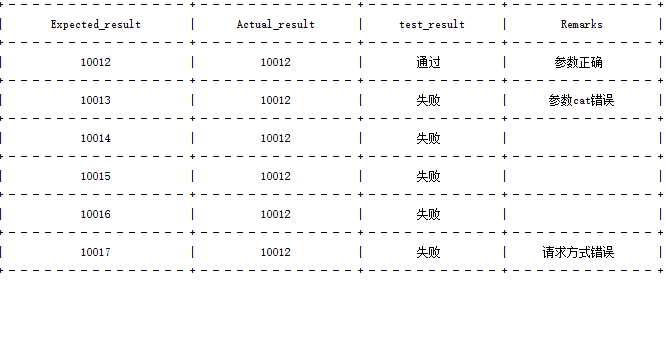用例设计:

执行用例代码:
# -*- coding: UTF-8 -*-
import xlrd,logging,urllib,urllib2,json,sys
from pylsy import pylsytable
#######################################################################################################
#定义系统输出编码
reload(sys)
sys.setdefaultencoding('utf-8')
#########################################################################################################
#定义日志输出
logging.basicConfig(level=logging.DEBUG,
format='%(asctime)s %(filename)s[line:%(lineno)d] %(levelname)s %(message)s',
datefmt='%a, %d %b %Y %H:%M:%S',
filename='myapp.log',
filemode='w')
#################################################################################################
#定义一个StreamHandler,将INFO级别或更高的日志信息打印到标准错误,并将其添加到当前的日志处理对象#
console = logging.StreamHandler()
console.setLevel(logging.INFO)
formatter = logging.Formatter('%(name)-12s: %(levelname)-8s %(message)s')
console.setFormatter(formatter)
logging.getLogger('').addHandler(console)
#################################################################################################
###################################################################################################
#处理excel表格
data = xlrd.open_workbook('C:UsersxxxxxDesktopAPI.xls')#打开excel表格
logging.info("打开%s excel表格成功"%data)
table = data.sheet_by_name(u'Sheet2')#打开工作表sheet2
logging.info("打开%s表成功"%table)
nrows = table.nrows#统计行数
logging.info("表中有%s行"%nrows)
ncols = table.ncols#统计列数
logging.info("表中有%s列"%ncols)
logging.info("开始进行循环")
name_1=[];url_1=[];params_1=[];type_1=[];Expected_result_1=[];Actual_result_1 =[];test_result_1=[];Remarks_1=[]#定义数组
Success=0;fail=0 #初始化成功失败用例
##################################################################################################################
for i in range(1,nrows):#遍历excel表格
cell_A3 =table.row_values(i)
#获取excel表格中的数据
name = cell_A3[0]
url = cell_A3[1]
params=eval(cell_A3[2])
type = cell_A3[3]
error_code =cell_A3[4]
Remarks =cell_A3[5]
logging.info(url)
#############################################################################################################################3
params =urllib.urlencode(params) #参数化处理
logging.info(params)
url2 = urllib2.Request(url,params)
print "***********开始执行请求************"
response = urllib2.urlopen(url2)
logging.info(response)
apicontent = response.read()
logging.info(apicontent)
apicontent = json.loads(apicontent)
#验证返回值
if apicontent["error_code"]==int(error_code):
name2="通过"
print name+"测试通过"
else:
name2="失败"
print name+"测试失败"
name_1.append(name)
url_1.append(url)
params_1.append(params)
type_1.append(type)
Expected_result_1.append(int(error_code))
Actual_result_1.append(apicontent["error_code"])
test_result_1.append(name2)
Remarks_1.append(Remarks)
if name2=="通过":
Success+=1
elif name2=="失败":
fail +=1
else:
print "测试结果异常"
##############################################################################################################################
#输出表格形式
attributes =["urlname","url","params","type","Expected_result","Actual_result","test_result","Remarks"]
table =pylsytable(attributes)
name =name_1
url =url_1
params=params_1
type=type_1
Expected_result=Expected_result_1
Actual_result =Actual_result_1
test_result=test_result_1
Remarks=Remarks_1
table.add_data("urlname",name)
table.add_data("url",url)
table.add_data("params",params)
table.add_data("type",type)
table.add_data("Expected_result",Expected_result)
table.add_data("Actual_result",Actual_result)
table.add_data("test_result",test_result)
table.add_data("Remarks",Remarks)
table._create_table()
print table
print "成功的用例个数为:%s"%Success,"失败的用例个数为:%s"%fail
print "***********执行测试成功************"
执行结果:


转载:http://www.cnblogs.com/liu-ke/p/6693257.html